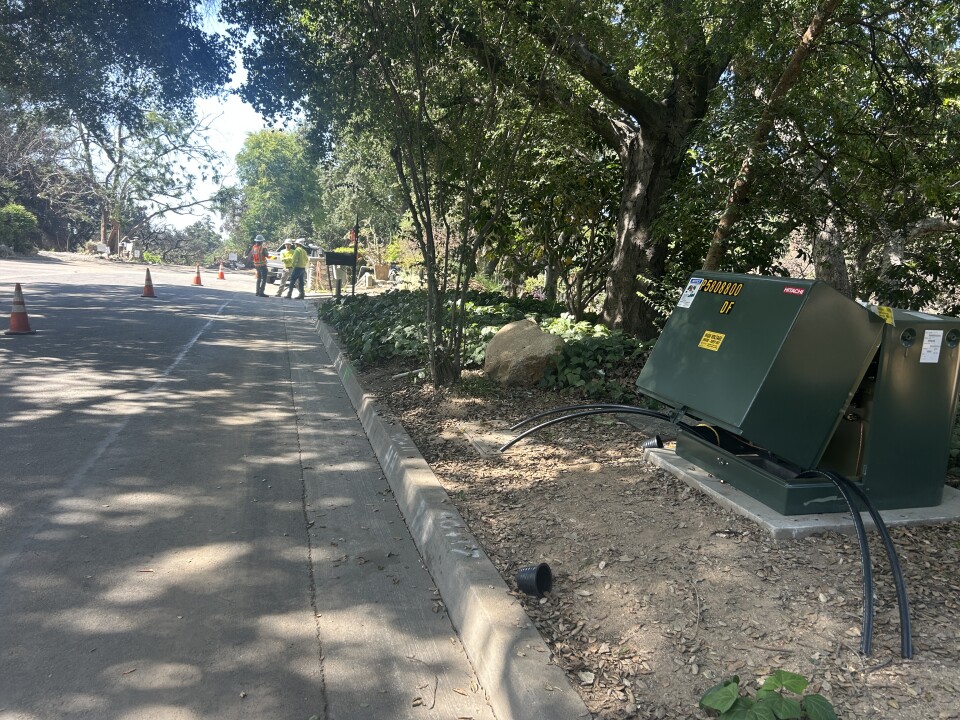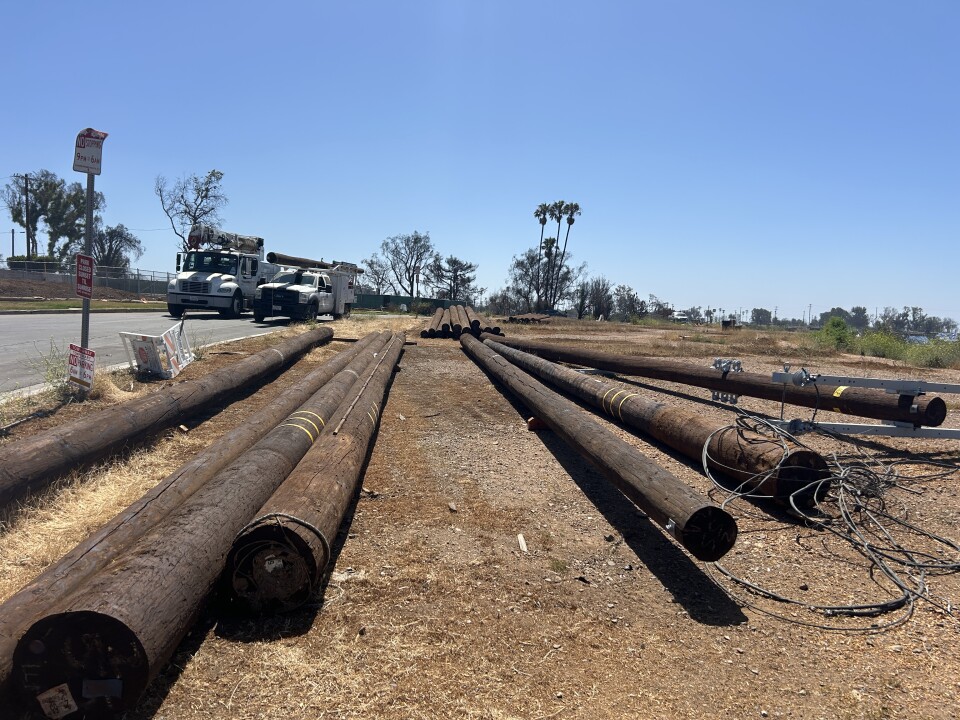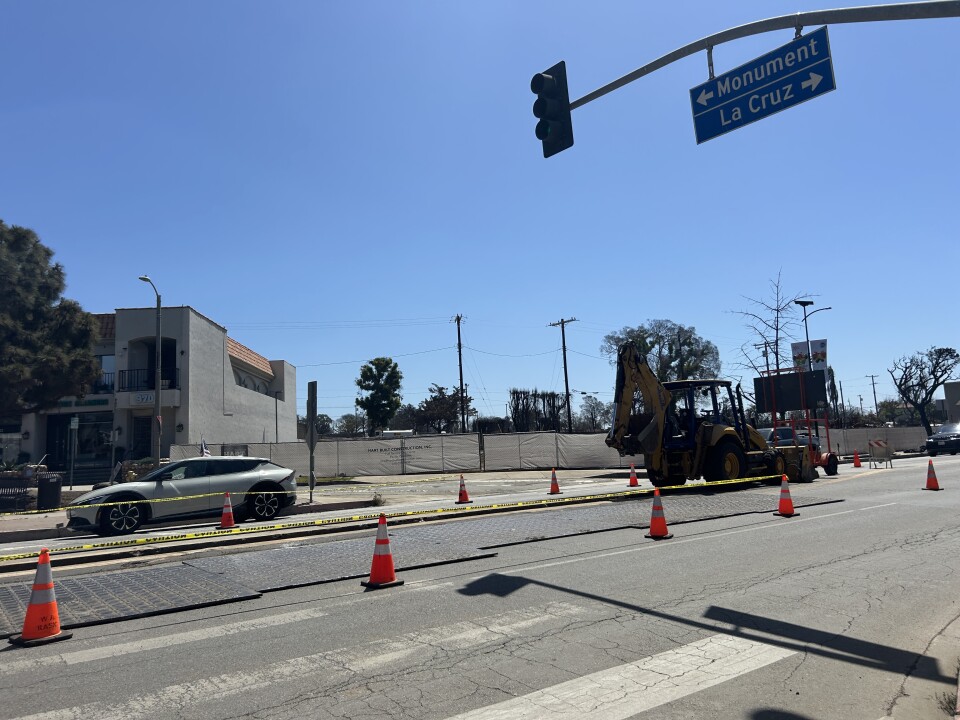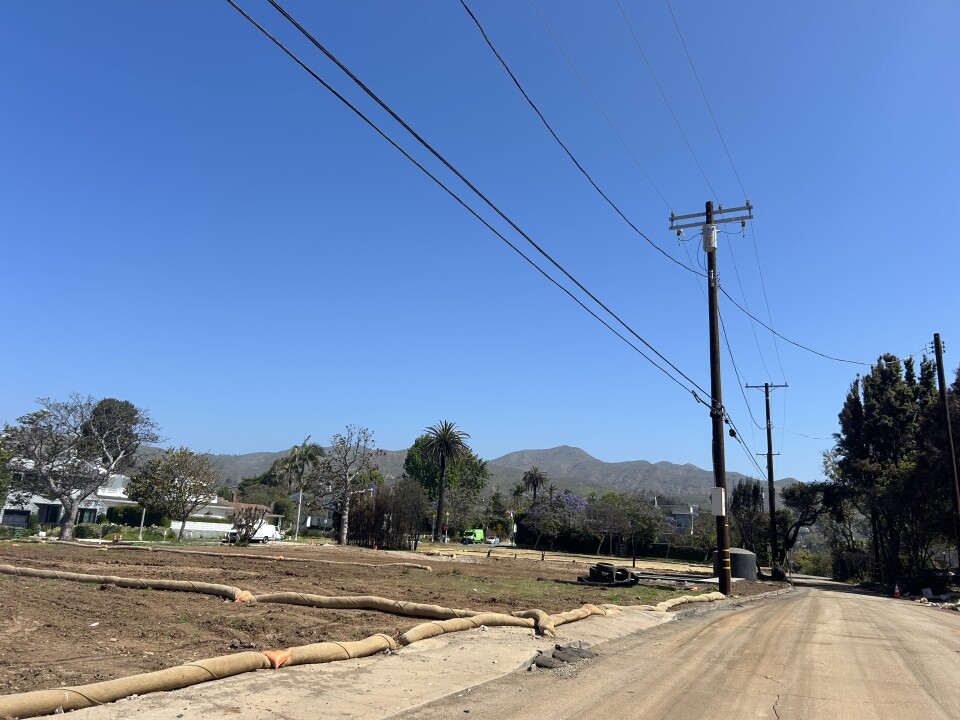Truth matters. Community matters. Your support makes both possible. LAist is one of the few places where news remains independent and free from political and corporate influence. Stand up for truth and for LAist. Make your year-end tax-deductible gift now.
As utilities start to bury power lines, homeowners are increasingly worried about the cost

More than half a year after January’s fires, utilities are slowly moving forward on their plans to put power lines underground.
Along the coast and in the foothills of the San Gabriel Mountains, the details for the plans are lacking — and in the case of the Palisades, yet to be developed.
As survivors start filing the paperwork to rebuild their homes, they worry they’re putting the cart before the horse.
In Altadena, many fire survivors are asking — is the Southern California Edison work to bury power lines worth the cost? In Pacific Palisades, where rebuild permits are being approved more quickly, building contractors are wondering — what exactly is the L.A. Department of Water and Power’s plan?
In both areas, successfully putting power lines underground will require buy-in from neighbors on each block. If there’s one holdout, it can render an entire undergrounding project unfeasible. These individual homeowners could foot up to $10,000 of the bill, though those costs are still being worked out.
After a flurry of calls to put more power lines underground from community members, local officials and Gov. Gavin Newsom himself, the challenges of actually doing it — including whether people can or are willing to pay for it — are mounting.
Why put lines underground?
The causes of both the Eaton and Palisades fires remain under investigation. The leading theory for the Eaton Fire is that a de-energized transmission line (those big power lines up in the mountains) somehow re-energized and sparked the fire.

Transmission lines are generally not buried underground because they’re often high above vegetation, are far apart from each other and are far less likely to spark fires. (Though when they do, it can be devastating — equipment on Pacific Gas & Electric transmission lines were found to be the cause of the deadly Camp Fire, which killed 85 people and razed the town of Paradise in Northern California).
In the Palisades, the leading theory is that a previous fire possibly reignited with the winds.
But in both areas, there’s evidence that downed distribution power lines — the lines that actually connect to our homes — sparked additional fires.
In Altadena, radio traffic shows how downed lines sparked new fires after Edison did not shut off power. In Pacific Palisades, a lawsuit representing more than 3,300 families alleges evidence of DWP downed power poles worsening the fires.

Putting distribution lines underground can almost completely reduce the risk of those lines sparking fires, as well as improve reliability. But it’s a lot more expensive than other fire-risk-reduction strategies, such as covered conductors or “fast trip” technology, which turns off the power automatically when a fault is detected on a line. Those strategies can reduce fire ignition risk by around 55% to 80%, respectively, and sometimes more, according to studies by utilities and academics.
But burying power lines also comes with advantages — the lines are insulated from the environment so they need less maintenance, and it can prevent the need to shut off power during dangerous fire weather (though it can extend outages when they happen since the lines are harder to reach).
Edison’s ratepayers largely have to foot the bill for these fire risk reduction strategies — from tree and vegetation management, to hardening infrastructure. It’s a big reason why electricity bills continue to rise — Edison estimates about 10% of our bills go toward wildfire mitigation.

How SoCal Edison is putting lines underground
In Altadena, about a mile of the trenching and equipment installation needed to put power lines underground has been completed so far along Sunny Oaks Circle and East Loma Alta Drive, just below the foothills. Many, though not all, of the houses in the area burned in the Eaton Fire. The utility was already planning to put these lines underground before the fire — now the work is being expedited.
Edison will need to secure about 30 easements from homeowners to successfully complete the remaining mile-and-a-half or so of this underground segment, said Shinjini Menon, Edison’s vice president of system planning and engineering.

Securing easements and rights of entry from full blocks of homeowners will be key to finishing all the underground projects, she said. Her team is managing the restoration work.
This part of Altadena is in a designated Very High Fire Hazard Severity Zone, which experts say is the ideal place to put power lines underground. About 40 miles of underground lines are planned in Altadena's high-risk zones.
“ We are doing this because it makes sense for the communities and we really need their help collectively to get all the easements and permits that we need,” Menon said.
The rest of Edison’s line mileage in the area — about 45 miles — are not in designated high-risk zones. Still, the utility said it plans to bury about 23 miles of those lines "given the amount damage that has happened where there are multiple homes along roads that have to be rebuilt,” Menon said. They're assessing an additional 19 miles for undergrounding in lower fire-risk areas.

When it comes to burying power lines, Menon said Edison considers "not only the benefits from the risk reduction from fire, but the long term benefits of, 'Hey, we don't have to trim the trees as much once we are underground. We don't have to inspect as frequently.' There are other benefits that come with it. So looking at the lifecycle view of it and saying, 'Where does it make sense?'”
At the same time, Menon said, the utility is upgrading the system to hold more electricity to deal with higher future demand. She said now is the time to do it, when the cost will be less than normal given the scale of destruction.
Cost worries residents
Edison officials say they have done extensive outreach with officials and community members about their plan to bury power lines, but many residents feel they’re still left in the dark, especially when it comes to how much the work may cost them.
Julian Saucedo and his wife lost their home of 35 years in Altadena. He lived far below the foothills and is still beyond the bounds of newly designated fire-risk areas.
Resources for residents
- SCE hotline for power supply questions: 1 (800) 250-7339
- Homeowners can visit SCE’s Disaster Recovery website for information about the company’s rebuild plan and targeted undergrounding: http://energized.edison.com/disaster-recovery
- SCE also has a guide to rebuilding
Still, Edison plans to bury the power lines that serve him and his neighbors as soon as the end of this year — and Saucedo’s not happy about it.
“It's been six months and little or nothing from [Edison] in terms of what they're doing in the undergrounding arena,” Saucedo said. “And we are beside ourselves.”
His biggest concern? The cost. In a letter to Newsom in mid-April, Edison Chief Executive Pedro Pizarro wrote it could cost individual homeowners $8,000 to $10,000 to connect to new underground lines, plus fees that may not be waived.
“Finding alternative ways to fund this significant out-of-pocket expense, including through government funds or philanthropic sources, could meaningfully assist customers in their rebuilding efforts,” Pizarro wrote.

A spokesperson for Edison told LAist they’re working with L.A. County to secure funding from the state’s office of emergency management, as well as the Federal Emergency Management Agency, to offset those costs.
But so far, no word on that additional money. And Saucedo and his neighbors are skeptical that support will ever come through.
Unlike required code upgrades, connecting to underground power lines is not covered by insurance. Saucedo worries the cost could be the straw that breaks the camel’s back, the difference for some neighbors between deciding to rebuild or leave.
He called the undergrounding effort by Edison “a money grab,” especially in areas that are not designated high fire risk, even if they burned in the Eaton Fire.
“We're quite a group of neighbors — we are all rallying behind each other,” Saucedo said. “A number of individuals are strongly opposed to undergrounding.”
Saucedo and his neighbors are advocating for homeowners to reject Edison’s right of entry and easement sale requests.
Instead, they’re planning to push for other, cheaper fire suppression methods, such as covered conductors or fast-trip sensors.
“We're worried that everyone's just going to sign these ROEs [rights-of-entry] and then we're all footing the bill,” said Nicole Wirth, an Altadena resident who lost her home and is a captain with grassroots group Altagether. She said they want more transparency about the costs from Edison. ”We don't have a ton of trust in Edison right now, and we don't have a ton of trust that the county is looking out for us.”

Amanda Riddle, lead attorney for the Eaton Fire lawsuit, said her clients could claim that cost as part of their damages.
“The costs shouldn't be on the ratepayers or homeowners at this point,” she said.
Edison has said they will pay homeowners a $500 stipend for the right of entry, plus whatever they’re owed for the sale of an easement.
“Our preference is to reach an agreement with the property owners,” said Edison spokesperson Gabriela Ornelas. “Delays into getting access to work on properties can slow down the collective effort to build back stronger. We are committed to working with the homeowners.”
Meanwhile, finding an accessible way to identify if their individual properties will be in areas with newly buried power lines has been a challenge for homeowners. Members of Altagether have been piecing details together using Edison’s public list of current undergrounding projects, then searching the names of the circuits in Altadena via this map.
In an FAQ Edison released in June, the utility said it is “developing a public ArcGIS map to show planned undergrounding areas.”
Putting the cart before the horse?
Beyond questions about costs, in Pacific Palisades, builders and residents are wondering why the Los Angeles Department of Water and Power is taking so long to develop a specific plan.
“ This plan should be done,” said Reza Akef, who was raised in the Palisades and now builds homes there via his company Metro Capital Builders.
Unlike in Altadena, the goal in the Palisades is to bury 100% of the lines in the neighborhood, which exists entirely in a designated Very High Fire Hazard Severity Zone.
Before the fires, about 48% of the lines in the Palisades were already underground, said Yamen Nanne, an assistant program management director with LADWP.
Palisades residents can find the latest rebuild information from LADWP here.
Nanne said the city-owned utility is putting together more specific plans that will be released at a town hall Aug. 27.
Part of the delay has been coordinating with telecommunications companies, who jointly own poles with LADWP but will have to foot the bill themselves to go underground with the utility.
“ Initially, we did get some concerns from the telecommunication companies about the costs associated with that,” said David Hanson, senior assistant general manager for LADWP’s power system at a July 2 town hall. “But we have had further meetings with the telecom companies and we're making some accommodations for them. So I feel confident that we're moving forward with both electrical and telecommunication underground.”

Burying lines will not be required in the Palisades — it will only happen if each neighborhood block agrees to it together.
“There's no mechanism for us to come in and essentially force folks to go underground,” Hanson said. “We want to provide the option, and if they don't want to take the option, it's fine with us. We'll harden your overhead system with another wildfire mitigation technique.”
Like Edison, DWP is also upgrading how much power the system can handle in the process. They’re doing that by expanding their station on Sunset Boulevard, where power lines are being put underground.
This will be the new “backbone” of the neighborhood’s upgraded electric system, a spokesperson for the utility said, and will allow the utility to abandon a plan for another distribution center near Marquez Elementary School, which had long faced resistance from the community.
The increased voltage LADWP is building into this system is another reason for delays.

“Since this is a new voltage not currently used anywhere else in LADWP service territory, special attention and consideration is being taken to ensure the system will be reliable for the homeowners and safe for our crews and inspectors constructing and operating the system,” said Mia Rose Wong, a spokesperson for the utility.
Hanson said that even without the specific plans yet in public hands, as long as homeowners who are rebuilding install an electrical panel that supports both underground and overhead electric service, they’ll be able to be hooked up to the underground system when LADWP gets to them.

Contractors are skeptical.
“That is so far from the truth of what it takes to underground power in Los Angeles,” Akef said.
He pointed out that when connecting to underground power, homeowners need to hire an electrical engineer who can provide more detailed plans to the city on their power needs beyond that electrical panel upgrade, such as how many amps are needed and the size and number of the conduit lines. Inspections from LADWP are required every step of the way, Akef said.
He worries that for those already rebuilding, it could cost them later if they get too far ahead of LADWP.
”Imagine those people who are building right now, for example, like if you finish your hardscape or your driveway, you would have to tear that all down,” Akef said. “You’d have to trench down three feet for this conduit and take it to the property line.”
Justin Skaggs, a utility consultant who specializes in overhead to underground conversion for power lines, said the “logistical puzzle” of burying lines in a timely manner in concert with homes being rebuilt requires more coordination with contractors and homeowners than is currently happening.
“Everyone's going to be on different timelines, so it's very difficult for anyone to be able to really logistically plan,” Skaggs said. “ It's going to be very challenging to coordinate. That's probably one of the biggest hurdles other than the funding.”













